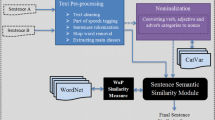Abstract
This paper addresses the issue of post-transfer process in paraphrasing. Our previous investigation into transfer errors revealed that case assignment tends to be incorrect, irrespective of the types of transfer in lexical and structural paraphrasing of Japanese sentences [3]. Motivated by this observation, we propose an empirical method to detect incorrect case assignments. Our error detection model combines two error detection models that are separately trained on a large collection of positive examples and a small collection of manually labeled negative examples. Experimental results show that our combined model significantly enhances the baseline model which is trained only on positive examples. We also propose a selective sampling scheme to reduce the cost of collecting negative examples, and confirm the effectiveness in the error detection task.
Preview
Unable to display preview. Download preview PDF.
Similar content being viewed by others
References
ACL. The 2nd International Workshop on Paraphrasing: Paraphrase Acquisition and Applications (IWP) (2003)
Carroll, J., Minnen, G., Pearce, D., Canning, Y., Devlin, S., Tait, J.: Simplifying text for language-impaired readers. In: Proc. of the 9th Conference of the European Chapter of the Association for Computational Linguistics (EACL), pp. 269–270 (1999)
Fujita, A., Inui, K.: Exploring transfer errors in lexical and structural paraphrasing. Journal of Information Processing Society of Japan 44(11), 2826–2838 (2003) (in Japanese)
Hofmann, T.: Probabilistic latent semantic indexing. In: Proc. of the 22nd Annual International ACM SIGIR Conference on Research and Development in Information Retrieval (SIGIR), pp. 50–57 (1999)
Ikehara, S., Miyazaki, M., Shirai, S., Yokoo, A., Nakaiwa, H., Ogura, K., Ooyama, Y., Hayashi, Y. (eds.): Nihongo Goi Taikei – A Japanese Lexicon. Iwanami Shoten (1997) (in Japanese)
Inui, K., Fujita, A., Takahashi, T., Iida, R., Iwakura, T.: Text simplification for reading assistance: a project note. In: Proc. of the 2nd International Workshop on Paraphrasing: Paraphrase Acquisition and Applications (IWP), pp. 9–16 (2003)
Keller, F., Lapata, M., Ourioupina, O.: Using the Web to overcome data sparseness. In: Proc. of the 2002 Conference on Empirical Methods in Natural Language Processing (EMNLP), pp. 230–237 (2002)
Kudo, T., Matsumoto, Y.: Japanese dependency analysis using cascaded chunking. In: Proc. of 6th Conference on Natural Language Learning (CoNLL), pp. 63–69 (2002)
Lapata, M., Keller, F., McDonald, S.: Evaluating smoothing algorithms against plausibility judgements. In: Proc. of the 39th Annual Meeting of the Association for Computational Linguistics (ACL), pp. 346–353 (2001)
Lee, L.: On the effectiveness of the skew divergence for statistical language analysis. In: Proc. of the 8th International Workshop on Artificial Intelligence and Statistics, pp. 65–72 (2001)
NLPRS. Workshop on Automatic Paraphrasing: Theories and Applications (2001)
Pereira, F., Tishby, N., Lee, L.: Distributional clustering of English words. In: Proc. of the 31st Annual Meeting of the Association for Computational Linguistics (ACL), pp. 183– 190 (1993)
Ravichandran, D., Hovy, E.: Learning surface text patterns for a question answering system. In: Proc. of the 40th Annual Meeting of the Association for Computational Linguistics (ACL), pp. 215–222 (2002)
Shirai, S., Ikehara, S., Kawaoka, T.: Effects of automatic rewriting of source language within a Japanese to English MT system. In: Proc. of the 5th International Conference on Theoretical and Methodological Issues in Machine Translation (TMI), pp. 226–239 (1993)
Takahashi, T., Iwakura, T., Iida, R., Fujita, A., Inui, K.: KURA: a transfer-based lexicostructural paraphrasing engine. In: Proc. of the 6th Natural Language Processing Pacific Rim Symposium (NLPRS) Workshop on Automatic Paraphrasing: Theories and Applications, pp. 37–46 (2001)
Torisawa, K.: An unsupervised learning method for associative relationships between verb phrases. In: Proc. of the 19th International Conference on Computational Linguistics (COLING), pp. 1009–1015 (2002)
Author information
Authors and Affiliations
Editor information
Editors and Affiliations
Rights and permissions
Copyright information
© 2005 Springer-Verlag Berlin Heidelberg
About this paper
Cite this paper
Fujita, A., Inui, K., Matsumoto, Y. (2005). Detection of Incorrect Case Assignments in Paraphrase Generation. In: Su, KY., Tsujii, J., Lee, JH., Kwong, O.Y. (eds) Natural Language Processing – IJCNLP 2004. IJCNLP 2004. Lecture Notes in Computer Science(), vol 3248. Springer, Berlin, Heidelberg. https://doi.org/10.1007/978-3-540-30211-7_59
Download citation
DOI: https://doi.org/10.1007/978-3-540-30211-7_59
Publisher Name: Springer, Berlin, Heidelberg
Print ISBN: 978-3-540-24475-2
Online ISBN: 978-3-540-30211-7
eBook Packages: Computer ScienceComputer Science (R0)




